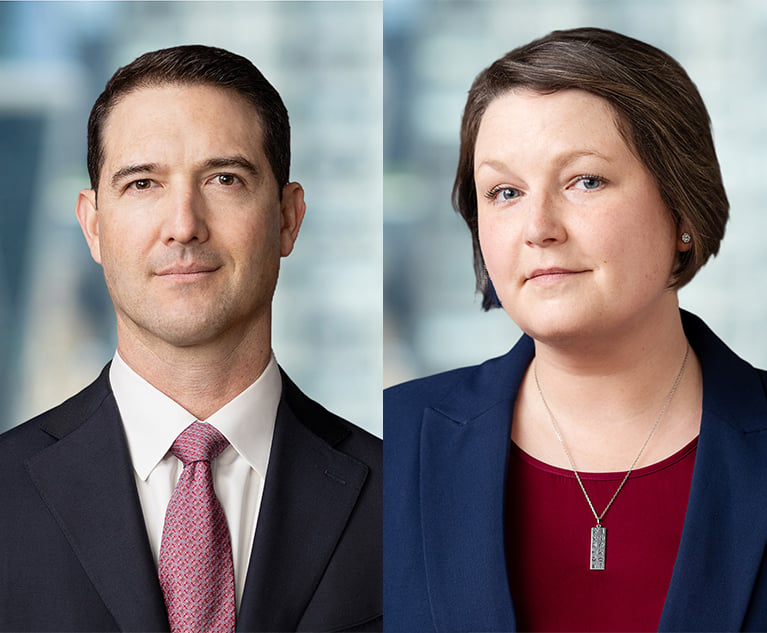 Midtown Manhattan. Photo: Ryland West/ALM
Midtown Manhattan. Photo: Ryland West/ALM The corporate opportunity doctrine precludes fiduciaries from "divert[ing] and exploit[ing] for their own benefit any opportunity that should be deemed an asset of the corporation." O'Mahony v. Whiston, No. 652621/2014, 2019 WL 4899030, at *6 (N.Y. Co. Oct. 4, 2019) (citing Alexander & Alexander of N.Y., Inc. v. Fritzen, 147 A.D.2d 241, 246 (1st Dep't 1989)). The doctrine is premised on the notion that a corporate officer or director may not personally profit at the expense of the corporation. See Troffa v. Troffa, No. 6095102016, 2022 WL 3140457, at *6 (Suffolk Co. Aug. 2, 2022). When a fiduciary usurps or diverts a corporate opportunity, "he may be held accountable for the fruits of his wrongdoing." Sheiffer v. Petry Holding, No. 601792/2004, 2005 WL 6578258 (N.Y. Co. 2005).
New York courts generally use two non-exclusive tests to determine whether the opportunity at issue was a corporate opportunity: (1) the tangible expectancy test and (2) the line of business test. While these tests help assess what constitutes a "corporate opportunity," some courts take a more general approach assessing all relevant factors. Recent Commercial Division cases applying these tests are discussed below.
This content has been archived. It is available through our partners, LexisNexis® and Bloomberg Law.
To view this content, please continue to their sites.
Not a Lexis Subscriber?
Subscribe Now
Not a Bloomberg Law Subscriber?
Subscribe Now
NOT FOR REPRINT
© 2025 ALM Global, LLC, All Rights Reserved. Request academic re-use from www.copyright.com. All other uses, submit a request to [email protected]. For more information visit Asset & Logo Licensing.
You Might Like
View All


Deal Watch: Private Equity Dealmakers Make 2025 Predictions Amid Deal Resurgence
12 minute readLaw Firms Mentioned
Trending Stories
- 1Former Thomas Clerk Sarah Harris to Serve as Acting Solicitor General
- 2Coral Gables Firm Secures $26M Settlement
- 3Trump's Second Term Spurs Unusual Alliances Between US and European Law Firms
- 4Honored by NYSBA, 2nd Circuit Chief Judge Livingston's Remarks Stress Judicial Safety
- 5Sanctioned Penn Law Professor Amy Wax Sues University, Alleging Discrimination
Who Got The Work
J. Brugh Lower of Gibbons has entered an appearance for industrial equipment supplier Devco Corporation in a pending trademark infringement lawsuit. The suit, accusing the defendant of selling knock-off Graco products, was filed Dec. 18 in New Jersey District Court by Rivkin Radler on behalf of Graco Inc. and Graco Minnesota. The case, assigned to U.S. District Judge Zahid N. Quraishi, is 3:24-cv-11294, Graco Inc. et al v. Devco Corporation.
Who Got The Work
Rebecca Maller-Stein and Kent A. Yalowitz of Arnold & Porter Kaye Scholer have entered their appearances for Hanaco Venture Capital and its executives, Lior Prosor and David Frankel, in a pending securities lawsuit. The action, filed on Dec. 24 in New York Southern District Court by Zell, Aron & Co. on behalf of Goldeneye Advisors, accuses the defendants of negligently and fraudulently managing the plaintiff's $1 million investment. The case, assigned to U.S. District Judge Vernon S. Broderick, is 1:24-cv-09918, Goldeneye Advisors, LLC v. Hanaco Venture Capital, Ltd. et al.
Who Got The Work
Attorneys from A&O Shearman has stepped in as defense counsel for Toronto-Dominion Bank and other defendants in a pending securities class action. The suit, filed Dec. 11 in New York Southern District Court by Bleichmar Fonti & Auld, accuses the defendants of concealing the bank's 'pervasive' deficiencies in regards to its compliance with the Bank Secrecy Act and the quality of its anti-money laundering controls. The case, assigned to U.S. District Judge Arun Subramanian, is 1:24-cv-09445, Gonzalez v. The Toronto-Dominion Bank et al.
Who Got The Work
Crown Castle International, a Pennsylvania company providing shared communications infrastructure, has turned to Luke D. Wolf of Gordon Rees Scully Mansukhani to fend off a pending breach-of-contract lawsuit. The court action, filed Nov. 25 in Michigan Eastern District Court by Hooper Hathaway PC on behalf of The Town Residences LLC, accuses Crown Castle of failing to transfer approximately $30,000 in utility payments from T-Mobile in breach of a roof-top lease and assignment agreement. The case, assigned to U.S. District Judge Susan K. Declercq, is 2:24-cv-13131, The Town Residences LLC v. T-Mobile US, Inc. et al.
Who Got The Work
Wilfred P. Coronato and Daniel M. Schwartz of McCarter & English have stepped in as defense counsel to Electrolux Home Products Inc. in a pending product liability lawsuit. The court action, filed Nov. 26 in New York Eastern District Court by Poulos Lopiccolo PC and Nagel Rice LLP on behalf of David Stern, alleges that the defendant's refrigerators’ drawers and shelving repeatedly break and fall apart within months after purchase. The case, assigned to U.S. District Judge Joan M. Azrack, is 2:24-cv-08204, Stern v. Electrolux Home Products, Inc.
Featured Firms
Law Offices of Gary Martin Hays & Associates, P.C.
(470) 294-1674
Law Offices of Mark E. Salomone
(857) 444-6468
Smith & Hassler
(713) 739-1250







